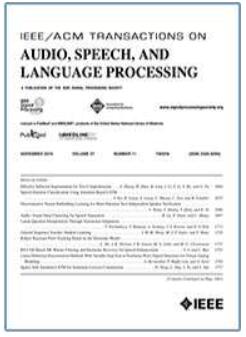学习多维扬声器定位:轴划分、无偏标签分布和数据扩充
IF 5.1
2区 计算机科学
Q1 ACOUSTICS
IEEE/ACM Transactions on Audio, Speech, and Language Processing
Pub Date : 2024-07-25
DOI:10.1109/TASLP.2024.3426309
引用次数: 0
摘要
多维扬声器定位(SL)旨在估计扬声器的二维或三维位置。多维扬声器定位的最新进展是使用特设麦克风阵列的端到端深度神经网络(DNN)。这种方法将 SL 问题转化为分类问题,即识别扬声器所在网格的问题。然而,这种分类方法有两个密切相关的弱点。首先,这种方法会引入量化误差,需要大量的网格来减少误差。然而,增加网格数量会导致维度诅咒。为了解决这些问题,我们提出了一种高效的多维 SL 算法,它有以下三个新贡献。首先,我们将高维网格划分解耦为轴划分,这大大缓解了维度诅咒。特别是针对多扬声器定位问题,我们在推理阶段采用了分离器来规避轴划分的置换模糊性。其次,我们引入了一种全面的无偏标签分布方案,以进一步消除量化误差。最后,我们提出了一套数据增强技术,包括坐标变换、随机节点选择和混合训练,以缓解过拟合和样本不平衡问题。我们在模拟数据和实际数据上对所提出的方法进行了评估,实验结果证实了这些方法的有效性。本文章由计算机程序翻译,如有差异,请以英文原文为准。
Learning Multi-Dimensional Speaker Localization: Axis Partitioning, Unbiased Label Distribution, and Data Augmentation
Multi-dimensional speaker localization (SL) aims to estimate the two- or three-dimensional locations of speakers. A recent advancement in multi-dimensional SL is the end-to-end deep neural networks (DNNs) with ad-hoc microphone arrays. This method transforms the SL problem into a classification problem, i.e. a problem of identifying the grids where speakers are located. However, the classification formulation has two closely connected weaknesses. Firstly, this approach introduces quantization error, which needs a large number of grids to mitigate the error. However, increasing the number of grids leads to the curse of dimensionality. To address the problems, we propose an efficient multi-dimensional SL algorithm, which has the following three novel contributions. First, we decouple the high-dimensional grid partitioning into
axis partitioning
, which substantially mitigates the curse-of-dimensionality. Particularly, for the multi-speaker localization problem, we employ a separator to circumvent the permutation ambiguity of the axis partitioning in the inference stage. Second, we introduce a comprehensive
unbiased label distribution
scheme to further eliminate quantization errors. Finally, a set of data augmentation techniques are proposed, including coordinate transformation, stochastic node selection, and mixed training, to alleviate overfitting and sample imbalance problems. The proposed methods were evaluated on both simulated and real-world data, and the experimental results confirm the effectiveness.
求助全文
通过发布文献求助,成功后即可免费获取论文全文。
去求助
来源期刊

IEEE/ACM Transactions on Audio, Speech, and Language Processing
ACOUSTICS-ENGINEERING, ELECTRICAL & ELECTRONIC
CiteScore
11.30
自引率
11.10%
发文量
217
期刊介绍:
The IEEE/ACM Transactions on Audio, Speech, and Language Processing covers audio, speech and language processing and the sciences that support them. In audio processing: transducers, room acoustics, active sound control, human audition, analysis/synthesis/coding of music, and consumer audio. In speech processing: areas such as speech analysis, synthesis, coding, speech and speaker recognition, speech production and perception, and speech enhancement. In language processing: speech and text analysis, understanding, generation, dialog management, translation, summarization, question answering and document indexing and retrieval, as well as general language modeling.
 求助内容:
求助内容: 应助结果提醒方式:
应助结果提醒方式:


